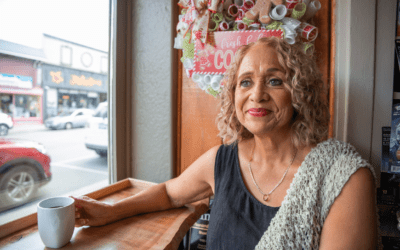
I placed one foot in front of the other, doing the mountaineering rest step.
The wind blew cold and sharp past my down jacket but I felt it on my face and my neck — the only exposed areas.
I could see no one before me and when I looked back, there was no one behind me. My fellow trekkers, all 39 of them, plus 13 Sherpas and 10 Porters, had either outdistanced me or had fallen back in exhaustion, suffering from the altitude and lack of air.
Hundreds of Buddhist prayer flags, strung across the top of the Stupa, were blowing in the fierce wind.
Then I saw them — four Himalayan wild dogs — they raised up from their resting position on the ledge of the Stupa – the high white mound that loomed 50 feet above me on my left. A stupa is a monument that marks the resting place of a Monk, a Nun or Sherpa who had died on that spot.
The dogs eyed me. I eyed them back. We both decided we were not threats to each other. They laid back down. I kept on walking. Left foot up. Rest. Step down. Right foot up. Rest. Step down. Left foot up. Rest, repeat…
Thoughts drifted in and out of my mind. I literally could see them coming and going. My thinking, which is usually at high speed, had slowed down to match my step.
Step up. Rest. With my next step down … The insights began to come to me.
WHY?
Why had I ventured on this trek to Mt. Everest Base Camp? What possessed me to fly to Kathmandu and then to that little Himalayan town, Lukla, 10,000 feet above sea level — to trek to the base of Mt. Everest – 18,000 feet above sea level — and back? 100 miles. 9 days up. 6 days down.
GRATITUDE
FORGIVENESS
PRESENCE
What prompted me to sign up for this?
During the Christmas to New Year’s break, I was invited to attend a Webinar. The speaker was a Canadian who had summited Mt. Everest just before his 70th birthday. Werner Berger is a Leadership coach, an entrepreneur, and a mountaineer. He used his experience of his summit to teach leadership in business. At the end of his webinar presentation he said, “I am planning a trek to Mt. Everest Base Camp. We leave on May 1st.”
I immediately thought. “I want to go.” And before I could talk myself out of it, I sent him an e-mail asking if there was room on the trek for one more person.
His reply came one hour later, “There is room for one more and I hope that is music to your heart.”
It was. I was also scared. What was I thinking? All of my fears started kicking in. But before I could get too lost in that way of thinking, I received an e-mail from Werner. He said, “I need you to confirm your place before the end of today because since your e-mail, I have had several others ask to join the trek and I now have a waiting list.”
My response was immediate. “I’m in”, I said.
During the masterminds I facilitate, we focus on the importance of being a decisive decision-maker in life and in business. In his book, Think and Grow Rich, Napoleon Hill says that, “successful leaders make decisions quickly and change their minds slowly.”
I have my own take on this. It may seem that successful leaders make decisions on the spur of the moment – just as I seemed to do about trekking up to the base of the highest mountain in the world – when, in fact, the germ of that decision may have been brewing for months, or even years, in the background. In their subconscious.
For me, shortly after I decided to go on that trek, I remembered seeing a television show when I was in my late teens. An 85 year-old woman was running up and down a mountain range in Arizona. When the reporter caught up with her for the interview, she was out of breath, but she had a wicked smile on her face as she said, “I love the feeling of exhilaration that comes with challenging my body and my mind to go up and down these hills.”
I recall thinking. “I want to be like that when I get to that age.”
I saw that interview when I was about nineteen. When I decided to trek to Mt. Everest, I was in my fifties.That idea brewed for a long time.

A year before deciding to go on my Mt. Everest trek, I had climbed up to the snow line, in July, on the side of the Garibaldi Mountains in Squamish, British Columbia, with a friend.
I realize, now, these two experiences had primed me for making what seemed like an instantaneous decision.
There is a term one of my coaches calls, “noodling”. He says it means thinking about a problem or something we want to create before we take action. My journalism professor at King’s College University, Dalhousie, calls it “creative procrastination.” Obviously, it took me a long time to get to the BIG climb, but I had several smaller climbs to help me noodle my way up the mountain.
HEALTH REASONS
I also had a health reason for going on this adventure. I knew that the training I would need to do before going on the trek, as well as the trek itself, would take my body to a new level of physical strength and resiliency that I had never experienced before.
I had things to do and I needed to be healthy to do them. There is a saying, “When a person is healthy they have hundreds of desires. When she is sick, she has only one.”
Most people believe their lives are over at fifty. I knew mine was just getting into high gear. Louise Hay, the author of the book, You Can Heal Your Life, has built a successful publishing business in Hay House, said on her eightieth birthday, “I am just getting started.”
I am priming myself for my eighties. I expect those to be my best years ever.
GRATITUDE
The Sherpas taught me about gratitude.
KP, our head Sherpa, stood with me early one morning, after breakfast, as we waited for the others to gather in the valley outside the “Happiness Inn” where we had eaten and slept the night before.
I watched the sun come up behind the seven highest peaks in the world. I looked at the pink and white Rhododendrons that lined the river path as we moved out on our trek that morning. I looked back at the Mountains and asked KP to name them all for me.
He stopped at one in particular and said, “That is the one we are particularly grateful for.”
Ama Dablam stands as wide as it is tall. It reaches out across the sky with arms outstretched.
“Why are you particularly fond and grateful for that one?” I asked.
“She is our mother. She looks out for us as we go up and down the mountains. She looks over our lives.”
Ama Dablam means “Our Mother.”
I looked at Ama Dablam and saw the divine majesty of a creator who cares for us and I was grateful with every fibre of my being.

I used to have a misunderstanding about happiness. I had the mistaken belief that my happiness and well-being in life were the product of my circumstances. The reality is that my happiness and well-being is ALWAYS my choice.
Can I make that choice? Can I choose to be grateful in every moment? The wonderful answer is yes, and in choosing happiness, gratitude, and hope in the face of uncertainty, loss, and even tragedy, we discover the truth of what holocaust survivor Viktor Frankl says, “the last of all human freedoms is the freedom to choose one’s attitude in any given set of circumstances — to choose one’s own way.”
So, I made my choice. I spoke my gratitudes into the wind and my voice was carried off into the majestic mountains.
With each step, I expressed gratitude for:
Every breath, I was able to take.
The gift of sight that allowed me to see the majestic mountains surrounding me.
My fellow trekkers.
The Sherpas looking after us.
Each member of my family.
My friends.
And I thought about forgiveness.
FORGIVENESS
“It’s one of the greatest gifts you can give yourself, to forgive. Forgive everybody.” ― Maya Angelou
I experienced this on the mountain. I started with myself.
I forgave myself for all the dreams I had ignored or abandoned. I forgave myself for sabotaging myself. Sabotaging my health with bulimia, in my teenage years. Sabotaging my relationships by not caring enough, by not being generous enough. By being selfish and self-serving. I forgave myself for not being where I wanted to be with my work and my life.
Then I forgave everyone who had ever hurt me or who I perceived had hurt me. I forgave the men who broke my heart. And I forgave myself for the hearts that I had broken. I forgave my mother, my best friend, for dying too soon and leaving me here without her. I forgave the friends that just disappeared out of my life. And I forgave myself for disappearing from the lives of others.
I shouted my forgiveness out to the mountains. I accepted forgiveness. My spirit became lighter. Although I had difficulty taking each breath, I felt myself walking with a lighter step.
PRESENCE
“When you are going through hell, keep going” ― Winston Churchill
The trek to Mt. Everest Base Camp was not only the most difficult challenge I had ever undertaken, physically. It was also the most mentally challenging.
On the 7th day of the trek, we stopped in Pheriche, the Himalayan Medical Rescue Station where the Everest Memorial was erected to pay tribute to all who had lost their lives on Everest. This plaque contains hundreds of names and is a chilling reminder of all who have lost their lives on Chomolungma (the Sherpa’s name for Everest).
I saw the red rescue helicopter take off. “Altitude sickness,” said the doctor. Altitude sickness can proceed quickly from disorientation and confusion to brain swelling from lack of oxygen. The person has to be taken down to a lower altitude quickly, or they will die within minutes.
At Pheriche, we were asked, “Do you want to end your trek here and go back down?”

We spent dinner weighing all the pros and cons as a group and at then end of the evening made our decision.
The next morning at 4 am, we all got up and did a small wash. Brushed our teeth with a half-cup of rationed water and the toothpaste we had brought. We had breakfast and then gathered our poles. No one was going back down. We were determined to push mentally and physically to see it through and to reach our goal.
We re-committed to looking out for each other. The Sherpas stayed even closer to our sides, looking for the first signs of altitude sickness — unsteady walking, confusion, or lethargy.
Sounds like life in general doesn’t it? Life can be confusing, throwing us off our balance, and tiring us out … and that’s on a good day.
When people ask me now, “How did you do it? How did you climb that mountain?”
The only answer I can give is, “One step at a time.”
My sister recently died after a long and painful struggle with breast cancer. I remember her doctor telling us: “Your sister is ‘actively dying’”.
The way I saw it was that her body may have been dying, but my sister, was actively living. Even then, only days before she passed away, she said to me, “Faith, I know I only have a short time to go but I want to enjoy every moment while I am here.” She was so strong.
We are all dying. Some of us have longer than others. But life is short.
My sister taught me, there is no need to rush to the finish line. It makes more sense to actively live — to be present in each moment — even in the face of death. This is mental toughness.
Presence has to do with how we show up each day and who we are.
My brother, Laurence died on March 9, of that same year.
The week before he died, he said a prayer of thanks over the last meal I saw him eat. He could only get down a few bites as myself and his eight year old daughter fed him.
In his prayer, he gave thanks for each member of his family — his wife, daughter, siblings, nieces, nephews, and friends. The prayer went on for four or five minutes, even though it took every ounce of his strength to draw each breath and say each and every word. This is mental toughness — the choice to think of others before himself. Even in the direst of circumstances.
My sister Claudette and my brother Laurence had character. Integrity, courage, perseverance, and were calm under extreme pressure. All those qualities they kept until the end.

BACK TO INSIGHT
So, there I was, in the flow. Trekking … left foot up. Rest. Step down. Right foot up. Rest. Right foot down, repeat.
Then came the insights:
All that really belongs to me in this world, is the ground beneath my feet. 9 inches. The size of my feet
Wherever I step, I belong. I can choose to bring my powerful self. I can bring my dreams, my desires, my heart, my soul, my love.
From this place where I stand, wherever it may be — whatever room I enter. Whatever mountain I climb.
From this place:
I can create the life I want.
I can bring into reality the dreams I dream.
I can advance without fear in the knowledge that I have been given by a divine source, everything I need to accomplish my purpose in this world.
In this place, where I stand, I am enough.
And what’s more, YOU are enough.



0 Comments